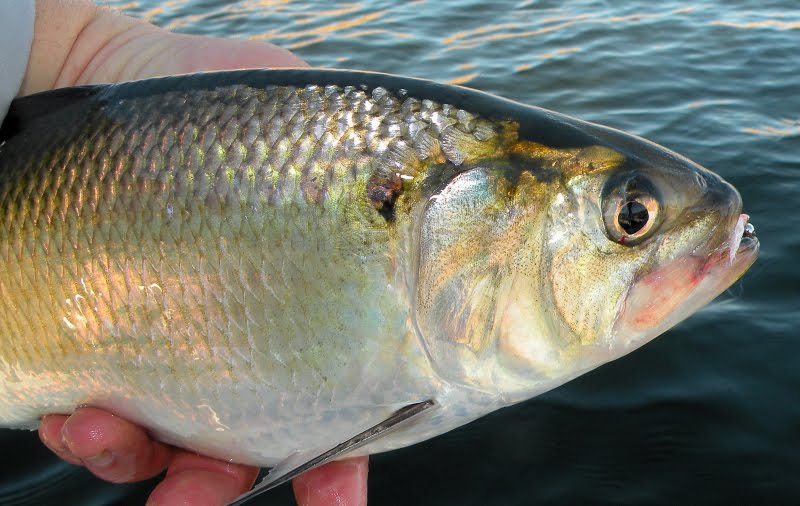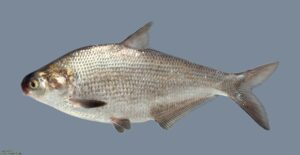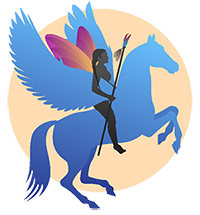“Are the Shads Running Yet?”
I love shad fish. It is very bony but the flesh is sweet and delicate. Some people like the roe (I am not one of those people!) that is either fried or broken into eggs to scramble or other variations that I didn’t care to investigate…feel free to admonish me on this point.
You have to be careful when preparing this fish because of its bony interior. Like salmon, you can remove the bones with tweezers after you filleted it but my mom said you should be able to fry it “hard” enough that you can eat it bones and all…I don’t like hard fried fish so that is a pass for me.
Shad fish has large scales, so let your fishmonger scale and filet it for you…or if you want to be self-reliant, take it outside, with several bowls of clean, cold water, wrapping paper, something to place your roe and fillets on, ice, a good sharp cutting or filet knife, and have at it.

To begin
Select fish that has clear eyes, and if purchased whole and already dressed, it should have very bright red blood; dark blood means old fish.
Scale and cut off the head. Slit belly CAREFULLY if you are using the roe (female shad is larger in length in comparison to the male) with your sharp knife. Carefully remove the sac(s) and rinse gently, cover and place on container sitting on ice. Continue to clean and rinse fish afterward.
Side note: Fish innards make great fertilizer. Either place it into the ground deep enough that Mr. Rodent and family, or your neighbor’s inquisitive cat, can’t dig it up, or use a gallon milk jug with water and place the innards in the water to ferment. Outside in the hot sun, it should break down in about two weeks, shake occasionally, mix with captured rain water for a delicious and fragrant (phew!) meal for your plants…your plants will thank you!
To filet
Hand flat on the fish, starting at the top, make your first cut between the bone of the fish and the flesh of the fish, slit down the entire side of the fish, place filet on chilled plate, flip fish over and repeat. The bony skeleton has enough meat on it that you can either: use for a good fish stock, OR, cut into pieces (your fish, your choice of sizes) to fry. WARNING, WILL ROBINSON! Here are the millions of thin bones location, this is where “frying hard” can be applied. Bones galore but still good eats!
Fish fry
Hot peanut oil (my choice, use vegetable or corn oil, or old-fashion “bacon drippings”), salt and pepper in a corn meal/flour mixture (I like using Jiffy Corn Meal mix with a little pancake mix to my mixture, not buttermilk version; it is very different in taste and texture for frying anything, but that is my preference!) and fry until golden brown on both sides or if using basket, golden brown.
Roe
Lightly coat with flour and corn meal (white corn meal is finer so I would use that), a half stick of butter, melted in hot pan, cook for about 2 minutes each side. Roe is delicate and should not be overcooked.
The finish
Potato salad (with boiled eggs and sweet relish!) and greens (mustard if you can, a sweet, mild flavor) and since we don’t have our Northern Neck Ginger Ale, a good cold glass of iced tea or lemonade ( a John Daly or an Arnold Palmer would do nicely, too). Hot sauce is a must in my kitchen.
The History of Shad Planking

Shad can either be fried, or smoked. Planking traditionally used oak wood planks that are thirty inches long, twenty inches wide and two and one-half inches thick over an open fire.
“The traditional event was originally a tribute to the start of the fishing season. The planking dates to the 1930s near Smithfield, Virginia, beginning as a small gathering of friends to celebrate the James River running of shad—the oily, bony fish smoked for the occasion on wood planks over an open flame. The unique shad cooking technique that is enjoyed today traces its roots to Mr. Paul Cox, of Surry County, Virginia. Mr. Cox, along with several Ruritans including Dr. E.C. Nettles and Mr. Richard Savedge, invited twenty-five of their friends to historic Wrenn’s Mill in Isle of Wight County, Virginia for their first Shad Planking. Having attended similar functions in the deep South, Mr. Cox introduced the group to the intriguing process of cooking 15 shad they had caught earlier in the day from the James River on hardwood planks over an open fire.
With Dr. Nettles’ suggestion and help, the Wakefield Ruritan Club later adopted this time honored tradition as an annual community and fund raising function in 1949. The event has been held on the third Wednesday in April each year ever since to herald the arrival of spring, with attendance increasing in size from the original 300 guests to over 2000 today. The site is the wooded property of a sportsmen’s club near U.S. Route 460 near the incorporated town of Wakefield in Sussex County, about an hour southeast of the Virginia State Capitol at Richmond. “
The Shad Planking is an annual political event in Virginia.
